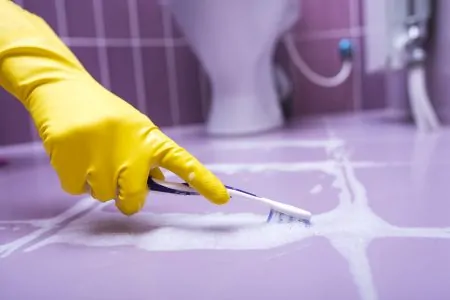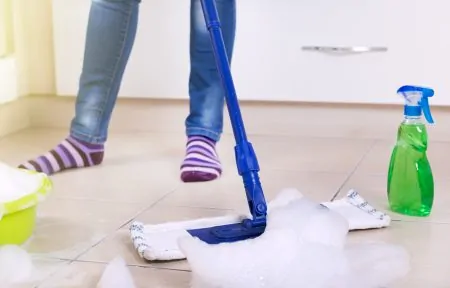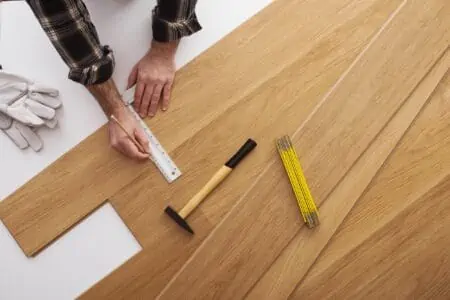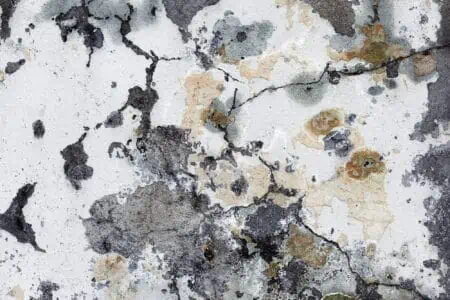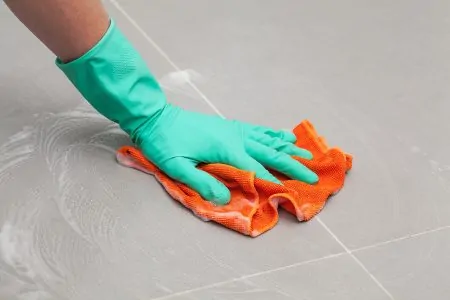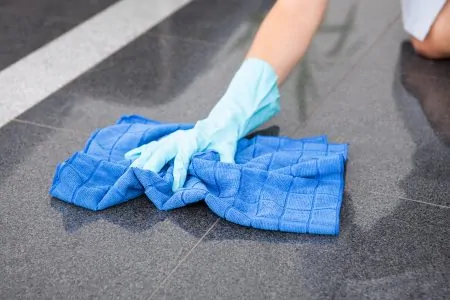Many homeowners don’t realize just how dirty their grout is until they clean it thoroughly. Some are even surprised to learn that they had white grout all along.
If you want to clean your floor grout and remove mold, we’ll show you how. There are many ways to clean grout, but this depends on a few factors, such as color and sealant.
We’ve got nine methods to share with you. This will ensure you find one that actually works for your grout.
Key Takeaways
- Grout can absorb dirt and spills, causing stains and providing a breeding ground for mold.
- Colored grout should be cleaned with specialized cleaners, while white grout can be cleaned with hydrogen peroxide or vinegar.
- Sealed grout requires different cleaning methods than unsealed grout, and natural stone tiles need special care.
- Various cleaning methods include hydrogen peroxide, baking soda, dish soap, oxygenated bleach, steam cleaners, and homemade solutions like vinegar or lemon juice.
Why Cleaning Grout Is Important
Because of the components grout is made of, it’s highly porous and will absorb dirt and spills. This will eventually stain your lines, making them look discolored and downright filthy.
Grout in areas with high moisture, such as bathroom floors, can become a thriving spot for mold. Dark areas around the toilet, behind a sink, in the shower, or tight corners, are perfect for mold to settle (1).
Unfortunately, getting rid of these potential health hazards isn’t an easy task. Regular cleaning and adequate ventilation can make all the difference.
Colored vs. White Grout
Grout comes in all different colors. Depending on the color of your grout, your cleaning approach may vary. Let’s walk through everything you need to know about colored vs. white grout.
1. Colored Grout
Avoid using bleach when cleaning colored grout. Bleach will discolor the grout and damage the tile depending on the type (natural stone, for example).
Some home remedies suggest the use of hydrogen peroxide. This may be a milder bleach, but it can still cause some damage and dull down the grout’s color.
You can find colored grout cleaners at any home improvement store, and they’re relatively safe to use. However, you should still read the label to ensure it’s right for your needs.
You can also use special products if your colored grout has been stained beyond repair. Try a Grout Pen in a suitable color — these will restore the look of your grout.
Do A Test
2. White Grout
White grout can become stained and filthy very quickly. However, if well-maintained, white grout can also bring a luxurious look and feel to a room.
Cleaning white grout can require some scrubbing, depending on how dirty it is. For this, you can use hydrogen peroxide to boost the process. A half and half mixture of white vinegar and water is also a very effective — and natural — way to clean white grout.
Sealed vs. Unsealed Grout
Since the most commonly used grout is porous cement-based, you should seal it. However, there are instances where it might be better to leave it unsealed.
1. Sealed
A sealer works by penetrating the grout and blocking the “pores.” This makes it impossible for fluids to penetrate later on.
Cleaning sealed tiles is reasonably easy. Because it’s sealed, the grout won’t be as dirty as unsealed. If you’re deep cleaning your tiles, it may just be enough to clean the grout.
There is debate on whether you can use vinegar to clean sealed grout.
However, making a diluted mix of vinegar and water in a spray bottle and applying it lightly should be just fine. Avoid leaving the vinegar on the grout for an extended time and repeat the process if necessary.
If you have natural stone tiles, avoid using vinegar as it will etch the surface.
2. Unsealed
Leaving your grout unsealed depends on the type. The common cementitious grout is porous and should be sealed. However, other types of grout don’t need a sealant.
Epoxy grout doesn’t contain Portland cement and doesn’t require water in the mixing process.
Because there is no cement or sand, epoxy doesn’t need to be sealed. It can, however, become stained. An excellent way to remove grime and stains from epoxy grout is by using bleach and water or vinegar and water (2).
If you have modified epoxy grout, you should avoid bleach as this can cause damage. Use vinegar with caution as you would with cementitious grout.
Best Tools to Clean Grout
You can clean grout lines effectively using a special grout brush. These brushes are usually nylon and small enough to fit the grout lines. Some are handheld, while others come with a wand to make it easier on the back.
Here are some other excellent tools you can use to clean grout lines:
- A toothbrush: Using an old toothbrush is excellent for grout. The small size and soft bristles create the perfect scrubbing tool to remove gunk. If you have an old electric toothbrush, even better — less scrubbing for you.
- A chisel tool: Using a chisel is an effective way to scrape away stuck grime. It can also remove stubborn mold.
- Steam: Cleaning grout with a steam cleaner is the easiest way to brighten the grout. Most steam cleaners or mops come with a special attachment for grout. If you’re struggling with mold, using a steam cleaner effectively kills and removes it.
How to Clean Floor Grout
Cleaning grout might involve significant scrubbing, but many methods and products can ease the process. Here are nine great grout cleaning methods.
Hydrogen Peroxide, Baking Soda and Dish Soap
Start by making a paste using a quarter cup of hydrogen peroxide and three-quarters of baking soda. Combine it in a bowl or container and add a tablespoon of dish soap.
Mixing hydrogen peroxide with baking soda creates oxygen ions — these act like mild bleach that will remove stains efficiently (3). The baking soda is naturally abrasive and is effective at scrubbing grout (4). Additionally, dish soap will dissolve and loosen grease, dirt, and gunk stuck in the grout.
If you have colored grout, test an inconspicuous area first. Although hydrogen peroxide is a mild bleach, it can discolor the grout depending on the quality.
After making sure it’s safe, apply to the grout using a nylon brush. The paste will likely begin to bubble as the components react to each other. This is normal, so don’t panic!
Leave the paste on the grout for up to 15 minutes before giving it a final scrub and rinsing with hot water to remove residue and dirt. Finish off by wiping the entire area using a clean cloth or rag.
Save Your Back
Oxygenated Bleach
If your white or light-colored grout looks filthy, this next method is for you. Oxygenated bleach is an eco-friendly alternative to regular household bleach.
Oxygen bleach is often found in detergents, also known as sodium percarbonate. It is formed from soda crystals and hydrogen peroxide and usually comes in its solid, powdered form.
When you need to use it, dilute it with water according to the label. As you might’ve guessed by the name, oxygen bleach creates oxygen ions when in contact with water. The bubbles make it so effective at stain removal — it lifts and dissolves stains and can break down bad odors (5).
For this method, dissolve two tablespoons of oxygen bleach in two cups of warm water. Do this in a spray bottle for your convenience. Avoid mixing the solution long before you plan on applying it, as the power of the bleach can wear off after a while.
If you have colored grout, remember to test the solution before applying it to a large area.
Pour or spray the liquid solution onto the grout. Scrub the grout using a nylon brush.
After scrubbing, allow the solution a couple of minutes to work. Scrub back and forth one more time.
If you notice darker spots or stubborn stains, dip the wet brush directly in the oxygen bleach and scrub. This will create a more potent solution.
Finish off by pouring water onto the area and mop to rinse and remove excess solution.
Chlorine Bleach
Chlorine bleach is a more traditional and effective way to clean grout and kill mold (6). However, be cautious because chlorine bleach is caustic to the skin and can create fumes that may be toxic. So always wear safety gear such as rubber gloves, goggles, and old clothes to avoid damage (7).
If you’re cleaning an enclosed room such as the bathroom, keep it well-ventilated by running a fan or opening a window or door.
Dip a brush into the undiluted bleach and scrub the grout vigorously. Rinse the area thoroughly using clean water and wipe with a clean cloth to absorb excess bleach and moisture. Finish off by drying the area with a towel.
If you have natural stone tiles, avoid leaving the bleach on the grout or tile for long. Try to keep it on the grout only to avoid damage.
Alkaline Cleaner
Alkaline cleaners are effective at removing stains from grout. To quickly clean the grout, you can buy commercial products, such as washing soda.
Mix the product as directed on the label. Avoid exceeding the recommended amount since it won’t make the solution more potent.
Use a sponge to apply the recommended solution to the grout and leave it for a few minutes. Scrub vigorously until the stains are gone, and finish off by rinsing the area thoroughly with clean water. Use a clean sponge to remove excess water and solution, then dry the area with a clean towel or cloth.
Steam Cleaner
Cleaning grout with a steam cleaner is an easy and effective way to restore your grout lines. If you have back problems or experience difficulty bending to scrub, a steam cleaner is the best option.
The hot temperature will also kill bacteria and mold while blasting dirt and grime without chemicals (8).
Start by attaching a small nylon brush to the wand. Fill the reservoir with the recommended amount of water, plug the steamer into an outlet and allow it to heat. A steam mop might be ready in less than a minute, while bigger steam cleaners will need eight or more minutes to heat fully.
Press the trigger to pump steam into the grout. Then scrub vigorously with the brush. Repeat until dirt, grime or mold is loose.
Use a clean rag, cloth, or sponge to wipe away the loosened gunk. If it’s extra dirty, use a mop and clean water to finish the job.
Steam cleaning grout shouldn’t remove the sealant unless it’s water-based. The steam will also not loosen or damage tiles. If you’re cleaning natural stone, keep the process as dry as possible by wiping each section as you finish.
Ammonia
Ammonia effectively disinfects your tiles and grout while removing stubborn dirt and stains. However, you must always start by opening windows or doors or turning on a fan. Also, wear rubber gloves and safety glasses (9).
Mix equal amounts of ammonia and water in a bucket or container. Dip a nylon brush or sponge in the mixture and apply it to the grout. Then scrub vigorously until the original color of the grout is restored and stains are gone.
Rinse the entire area using clean water and a sponge. Finish off by drying the floor using a clean towel.
Danger
Warm Water and a Stiff Brush
A simple and easy way to clean slightly dirty grout is by using warm water and a stiff brush. The warm temperature of the water helps to loosen dirt so that you can easily scrub it away.
Pour the warm water directly onto the grout and begin to scrub it immediately while it’s still warm. Wipe away excess dirt and water using a clean cloth or sponge. Finish off by drying the area with a towel.
Homemade Grout Cleaners
Baking Soda and Vinegar
The combination of abrasive baking soda and acidic vinegar makes for an excellent grout cleaner and deodorizer. It’s also natural, which is good for those who want to avoid chemicals.
Combine three parts of baking soda with one part vinegar in a bowl. Mix until it forms a thick paste.
Beware
Apply the paste directly onto the grout using your finger or a dry sponge. You might want to wear rubber gloves for this if you have sensitive skin.
Mix equal parts of vinegar and water in a spray bottle and apply it to the paste. There will be a bubbling reaction as the vinegar contacts the paste.
Once the solution stops bubbling, use a grout or nylon brush to scrub the lines.
Finish the process by mopping with clean water to rinse the area. Rinse your mop throughout the last step to avoid spreading a residue.
Although this method is highly effective, you should also be careful. If you have cementitious grout installed, the acid in the vinegar might dissolve the cement.
Take Note
Lemon Juice
Lemon is an effective natural cleaner that’s often taken for granted. The acid cuts through grease, dirt, and grime while also bleaching the area slightly, restoring the grout color.
Start by saturating the grout with lemon juice and allowing it to sit for up to 15 minutes. Then scrub the grout using a small brush. Finally, rinse with clean water and wipe with a towel to dry.
Final Tips
Keeping your grout clean might seem like an immense job. However, you can keep it stain-free by giving it an occasional deep clean. Follow these last few tips to maintain your grout:
- Clean spills immediately: Even if you have sealed grout, it’s still essential to clean spills as they happen. This will prevent liquids from soaking into the grout and leaving a stain.
- Test new cleaners: If you’re using a new cleaner, whether commercial or homemade, always give it a test in an inconspicuous area first. Look out for any discoloration or signs of damage.
- Consider your tiles: Natural stone is sensitive to acidic products. You should, therefore, avoid using vinegar or lemon juice when cleaning the grout as it can damage the surface. Instead, opt for a pH-neutral cleaner.
- Use a wand: Unfortunately, cleaning grout involves a lot of scrubbing, and you often have to spend a significant amount of time on your knees. If you find this difficult, choose a tool with a wand. Many grout brushes will come with an extendable wand to make the process easier.
- Avoid hard tools: Don’t use steel wool or wire brushes as these can damage or break the grout.
- Seal the grout: The Tile Council of America recommends that you seal your grout using a high-quality sealant when it’s dry. There are three application styles available for grout sealants. These include brush-on, rollers, and sprays.
- Use a grout pen: When all other methods don’t work, or your grout is beyond repair, try a grout pen. These are available in various colors to suit your grout. If you have white grout, try the Clorox Bleach Pen to restore the bright grout.
